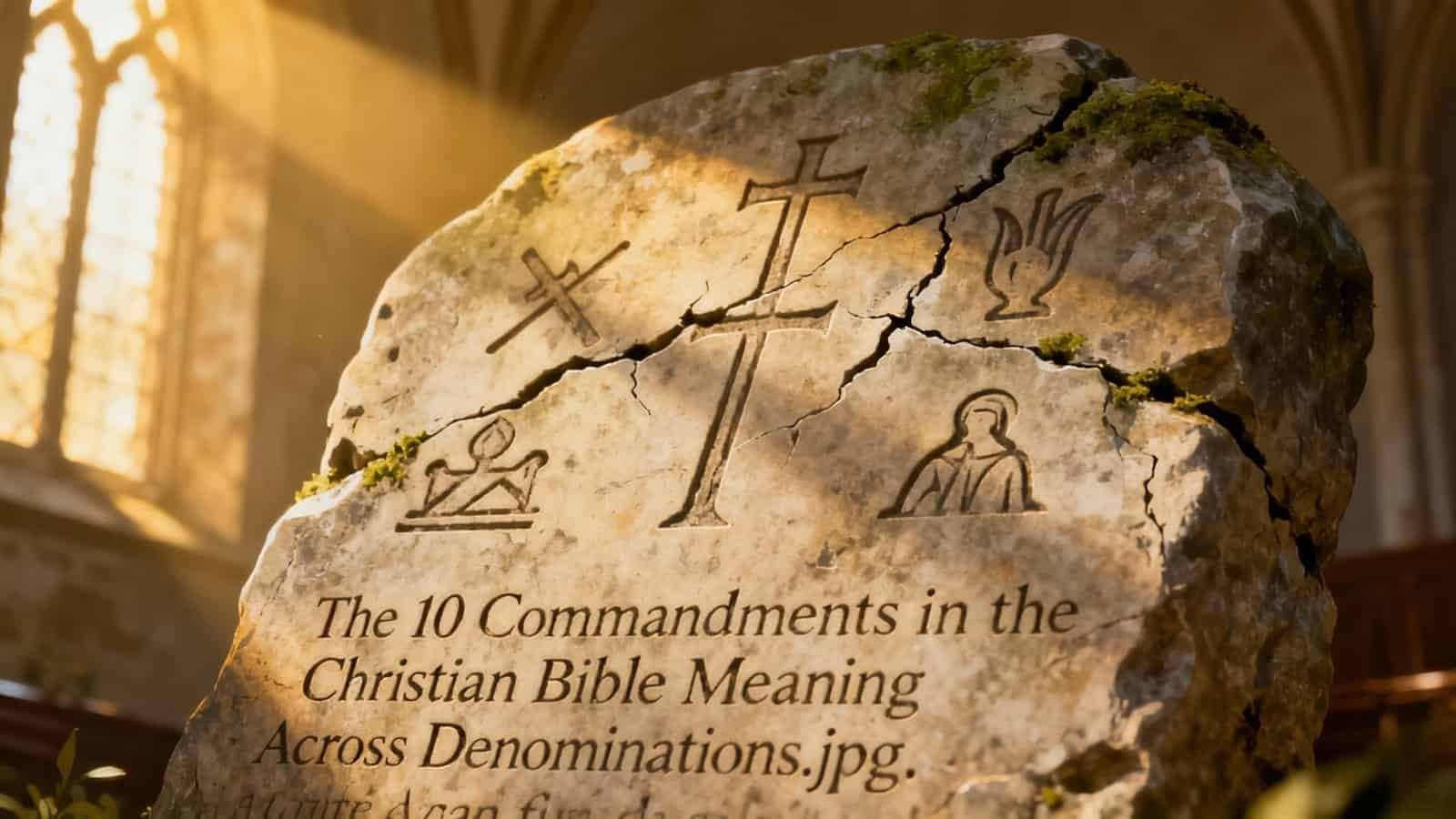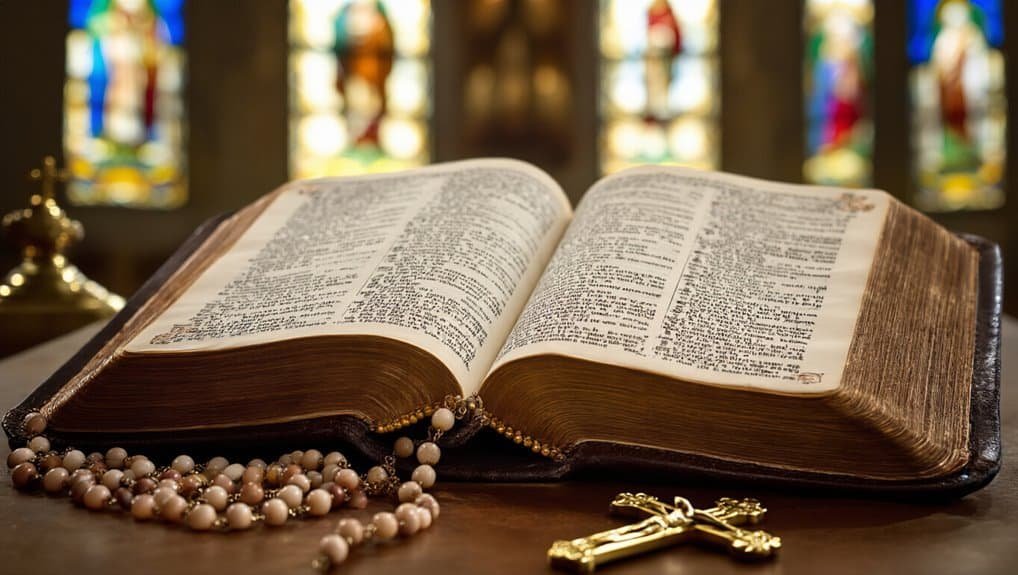
25 Nov The 10 Commandments in the Christian Bible: Meaning Across Denominations
You’ll discover that Christian denominations interpret the Ten Commandments through distinct theological lenses. Catholics emphasize natural law and sacramental reconciliation; Protestants stress grace and scriptural authority; Orthodox Christians focus on theosis and spiritual transformation. They even number the commandments differently, reflecting divergent hermeneutical priorities. Beyond these foundational frameworks lie intricate debates about the commandments’ binding authority, their reinterpretation for contemporary contexts—from digital idolatry to work-life balance—and how communities navigate unity amid genuine theological particularity.
Table of Contents
Key Takeaways
- Catholic and Protestant traditions number the Commandments differently; Catholics combine coveting prohibitions while Protestants divide them into two separate commandments.
- Protestant theology views the Law as pedagogical, exposing sin and pointing to Christ rather than serving as a path to salvation.
- Catholic moral theology integrates the Decalogue with natural law and virtue ethics, emphasizing interior transformation beyond external compliance.
- Orthodox Christianity frames the Commandments as expressions of God’s love enabling theosis (spiritual deification) through sacramental and ascetical practice.
- Denominational differences stem from distinct hermeneutical traditions: Protestant sola scriptura, Catholic magisterial authority, and Orthodox liturgical-sacramental emphasis shape interpretive outcomes.
Historical Origins and Biblical Context

When you examine the Ten Commandments‘ origins, you’re tracing a textual tradition embedded within Israel’s covenant narrative rather than accessing a single, univocal historical moment. The commandments appear in Exodus 20 and Deuteronomy 5, with variations that reflect distinct theological emphases across sources.
You’ll find the Covenant Context crucial for understanding these precepts. They’re presented as God’s stipulations within a covenant relationship, establishing reciprocal obligations between deity and people. This framework shapes how you interpret each commandment—not as isolated ethical rules, but as relational markers defining Israel’s identity.
In Early Judaism, scribal traditions preserved and elaborated these commandments through interpretive layers. You’re encountering not merely ancient legal codes, but theological statements responding to evolving historical circumstances. The duplication across biblical texts suggests redactional processes that you must consider when assessing authenticity and original intent.
Variations in Numbering and Categorization Across Denominations
You’ll discover that Catholic and Protestant traditions enumerate the Commandments differently, with Catholics combining the prohibition against coveting into one commandment while Protestants divide it into two, thus creating divergent numbering systems that reflect theological priorities.
The Orthodox Church further complicates this landscape through its own categorization schema, which emphasizes particular commandments’ moral weight differently than Western Christianity. These variations become especially pronounced regarding image worship and idolatry, where you’ll find that the Orthodox treatment of icons and their theological justification creates distinct interpretive boundaries that separate their numbering from both Catholic and Protestant frameworks.
Catholic and Protestant Divisions
Though the Ten Commandments appear foundational to Christian ethics, they’ve not remained uniform across denominational lines—a divergence rooted in differing hermeneutical traditions and liturgical practices rather than scriptural disagreement.
You’ll find Catholics and Protestants enumerate the commandments differently: Catholics combine the prohibitions against coveting into one commandment, while Protestants separate them. These confessional differences extend beyond mere enumeration; they reflect deeper theological commitments regarding idolatry and desire.
Additionally, interpretive frameworks diverge when addressing image veneration—a distinction historically tied to broader ecclesiastical practices like clerical celibacy in Catholic tradition.
You’ll recognize that these variations demonstrate how denominational identity shapes biblical hermeneutics, illustrating that scriptural interpretation remains inseparable from theological and institutional contexts rather than existing as neutral exegetical enterprise.
Orthodox Numbering System Differences
Beyond the Catholic-Protestant divergence lies yet another significant variation: the Eastern Orthodox tradition employs its own enumeration scheme that reflects distinct theological priorities and liturgical needs.
You’ll notice that Orthodox Christians combine the prohibition against idolatry with the commandment against graven images, treating them as unified rather than separate injunctions. This categorization stems from liturgical variations embedded within monastic traditions, where icon veneration holds theological significance absent from Western frameworks.
Consequently, you’re working with a different structural arrangement that consolidates commandments differently regarding coveting—merging desires for neighbors’ possessions into singular categories.
These Orthodox distinctions aren’t arbitrary; they emerge from centuries of exegetical development and ecclesiastical practice. Understanding these enumeration differences proves essential when examining how various Christian traditions interpret and apply biblical law, revealing how theological context shapes scriptural interpretation across denominations.
Image Worship and Idolatry
The distinctions between image worship and idolatry reveal how denominations fundamentally interpret the Second Commandment’s scope and application.
You’ll find that Catholic and Orthodox traditions distinguish between latria (worship) and dulia (veneration), permitting icon veneration as theologically legitimate. They argue you’re honoring the person depicted, not the physical object itself.
Protestant reformers reject this nuance, viewing such practices as dangerously close to idolatry. They contend you can’t meaningfully separate the image from worship directed toward it.
This theological divide reflects deeper concerns about popular superstition infiltrating religious practice. Your denominational framework shapes whether you see icon veneration as reverent devotion or prohibited idolatry, illustrating how interpretation of ancient commandments generates contemporary ecclesiastical boundaries.
Catholic Interpretation and Application

Within Catholic theological tradition, you’ll find that the Decalogue functions not merely as a legal code but as a comprehensive moral framework rooted in natural law and divine revelation. The Church emphasizes that these commandments reflect eternal moral principles accessible through reason, yet perfected through Christ’s redemptive work.
Your understanding deepens through liturgical formation, where the commandments permeate worship and prayer. The sacramental theology undergirding Catholic practice reveals how grace enables you to fulfill these precepts authentically. Confession provides reconciliation when you transgress; the Eucharist strengthens moral resolve.
Catholic moral theology integrates the commandments with virtue ethics, particularly the cardinal virtues. You’re called not merely to external compliance but to interior transformation—cultivating habits that align your will with God’s eternal law. This approach transcends legalism, positioning obedience as loving response rather than burdensome obligation, thereby sanctifying your daily existence through integrated moral living.
Protestant Understanding and Emphasis
When you examine Protestant perspectives on the Ten Commandments, you’ll discover that reformers fundamentally reframed the law’s function through the lens of grace, arguing that Christ’s redemptive work liberates believers from legalistic bondage while the commandments remain morally binding guides for Christian living.
You must understand that Protestant thinkers like Luther and Calvin distinguished sharply between the law’s role in condemning sin and its role in sanctifying the redeemed, positioning obedience not as a prerequisite for salvation but as a Spirit-empowered response to divine grace.
Your interpretation of Scripture’s authority on this matter hinges on recognizing how Protestants grounded their ethical framework directly in biblical texts rather than ecclesiastical tradition, making sola scriptura the interpretive foundation for how you’ll understand the commandments’ ongoing relevance.
Grace and Moral Law
Arising from the Reformation’s recovery of Pauline theology, Protestant thought fundamentally reconceives the relationship between divine grace and moral obligation, rejecting the medieval synthesis that treated the Decalogue as a ladder of merit.
You’ll find that Protestants navigate soteriological tensions by distinguishing justification through faith alone from sanctification’s gradual moral transformation. They argue grace doesn’t eliminate the Law’s binding ethical force; rather, it liberates believers from legalistic salvation-seeking while preserving the Commandments’ normative authority for Christian conduct.
This framework resists ethical relativism by grounding morality in God’s immutable character rather than human achievement. You’re thus encountering a paradox: grace frees you from Law’s condemnation precisely so you’re empowered to fulfill its righteous demands authentically.
Reformation Perspectives on Obedience
This soteriological reframing necessitates reconsidering what obedience actually means for the Christian life.
During the Reformation, Protestant thinkers fundamentally reoriented moral obedience away from meritorious works toward grateful response to divine grace. You’ll discover that Luther and Calvin distinguished sharply between legalistic compliance and authentic Christian obedience rooted in faith. Rather than viewing the Commandments as earning salvation, Reformation obedience emerges as evidence of regeneration—fruit flowing from transformed hearts.
Pastoral authority shifted accordingly. Reformers positioned clergy as guides illuminating Scripture’s demands rather than intermediaries dispensing grace through sacraments. You’re thus encountering a democratization of moral interpretation, where individual conscience, informed by biblical study, assumes greater weight. This Protestant framework established obedience not as institutional requirement but as personal commitment reflecting genuine conversion and sanctification.
Scriptural Authority in Practice
Because Protestants relocated moral authority from ecclesiastical institutions to Scripture itself, they’d necessarily developed rigorous hermeneutical methods for discerning the Commandments’ contemporary application. You’d find that Protestant exegesis emphasizes the Commandments’ abiding moral principles rather than ceremonial specifics, distinguishing between cultural context and universal ethical demands.
This approach demands you engage Scripture directly, bypassing church authority as interpretive mediator. Your practical obedience flows from personal conviction grounded in textual analysis, not institutional mandate. You’re called to examine how each Commandment functions within its redemptive-historical framework, then apply its underlying principle to modern circumstances. This methodology reflects Protestant conviction that Spirit-illuminated Scripture sufficiently guides believers toward righteous living without hierarchical ecclesiastical guidance.
Orthodox Christian Perspective

Within the Eastern Orthodox tradition, the Ten Commandments aren’t viewed as a legalistic code but rather as expressions of God’s love that reveal humanity’s proper relationship with the Divine and neighbor. You’ll find that Orthodox theologians emphasize theosis—deification—as the ultimate goal, with the Commandments functioning as foundational steps toward spiritual transformation rather than mere moral obligations.
The liturgical symbolism embedded within Orthodox worship reinforces these precepts through repeated ceremonial enactment and theological meditation. You encounter the Commandments not as abstract rules but as lived realities within the Church’s sacramental life.
Additionally, monastic ethics have profoundly shaped Orthodox interpretation. You’ll observe that desert fathers and contemporary monastics view the Commandments as invitations to ascetical practice and union with Christ. This perspective integrates ethical obedience with mystical experience, positioning the Commandments as doorways to divine encounter rather than endpoints in themselves. Consequently, you’re encouraged toward holistic spiritual development encompassing intellect, will, and heart.
The Role of the Law in Salvation Theology
While Orthodox spirituality emphasizes the Commandments as transformative invitations toward union with God, Christian soteriology—the doctrine of salvation itself—grapples with a more fundamental question: does obedience to the Law secure salvation, facilitate it, or remain altogether separate from it?
You’ll find that Protestant traditions, particularly Lutheran and Reformed theology, insist that legal fulfillment can’t justify you before God. They argue that Christ’s redemptive work supersedes Mosaic requirements, rendering the Law pedagogical rather than soteriologically efficacious. Conversely, Catholic and Orthodox frameworks maintain nuanced positions: the Law retains spiritual value as you cooperate with divine grace, though salvation ultimately depends on Christ’s sacrifice, not your observance.
The soteriological implications prove decisive here. You must recognize that how you interpret the Law’s salvific role directly shapes your understanding of grace, faith, and obedience‘s relationship. This theological tension remains central to Christian identity formation and denominational distinctiveness.
Commandments in Modern Worship and Practice
Contemporary Christian communities continually grapple with integrating the Ten Commandments into liturgical life and ethical formation, even as the soteriological debates outlined above persist.
Contemporary Christian communities navigate the persistent challenge of meaningfully integrating the Ten Commandments into both liturgical practice and ethical formation.
You’ll find that many congregations embed the Decalogue within liturgical music, employing it as a pedagogical device that reinforces moral consciousness during worship.
Pastors engage in pastoral counseling that draws explicitly on commandment-based frameworks, helping parishioners navigate ethical dilemmas through this ancient moral vocabulary.
Your denomination’s approach varies considerably: some traditions recite the Commandments corporately, while others emphasize selective application. Reformed communities often stress their normative function, whereas Lutheran and Catholic contexts highlight interpretive flexibility.
Contemporary worship increasingly contextualizes these precepts within discussions of justice, reconciliation, and communal accountability.
You’ll observe that practitioners don’t simply inherit medieval formulations but actively reinterpret them through contemporary lenses, ensuring the Decalogue remains a living ethical resource rather than antiquated legislation.
Denominational Debates on Binding Authority
As you engage with Christian theological discourse, you’ll find that fundamental disagreements about the Ten Commandments‘ binding authority persist across denominational lines, generating interpretive frameworks that diverge sharply on questions of moral obligation and scriptural hermeneutics.
You’ll encounter the binding debate most acutely between Protestant and Catholic traditions, where ecclesial authority claims intersect with canonical primacy determinations. Reformed theologians emphasize the Decalogue’s perpetual moral dimension, whereas Dispensationalists argue for its ceremonial obsolescence under grace.
You’ll notice liturgical variance reflects these hermeneutical divisions—some traditions incorporate commandment recitations into worship while others minimize their liturgical prominence.
Catholic theology grants magisterial authority decisive interpretive weight regarding commandment application, contrasting sharply with Protestant sola scriptura positions.
As you navigate these denominational perspectives, you’ll recognize that ecclesial polity fundamentally shapes how communities understand the commandments’ contemporary relevance and theological binding force.
Cultural and Ethical Applications in Contemporary Society
The commandments’ ethical relevance doesn’t diminish in modern contexts—rather, it demands rigorous reinterpretation that accounts for technological, social, and institutional transformations unknown to ancient Israel. You’ll find that cultural ethics frameworks help bridge ancient wisdom and contemporary dilemmas. The prohibition against idolatry, for instance, now encompasses digital reverence—your relationship with technology, social media algorithms, and consumerism. Sabbath observance transforms into questions about work-life balance and digital detox. Honoring parents extends to elder care systems and bioethical decisions. You’re tasked with extracting underlying principles rather than literal compliance. This hermeneutical approach recognizes that commandments address fundamental human orientations: toward God, community, and creation. Contemporary application requires you to identify the commandments‘ theological intent, then thoughtfully translate them into your lived context, acknowledging both continuity with tradition and genuine ethical novelty.
Unity and Diversity in Christian Moral Teaching
While your contextual reinterpretation of the commandments reveals how individual Christians navigate moral life, you’ll find that Christianity’s ethical witness doesn’t emerge from isolated conscience alone—it’s fundamentally communal and multifaceted.
You encounter this complexity through communal ethics, where congregational discernment shapes moral understanding across denominations.
Liturgical unity reinforces shared values through worship practices, yet you recognize that pastoral challenges arise when interpreting commandments for diverse cultural contexts.
Your engagement with ecumenical dialogue reveals how different traditions maintain distinct emphases—Catholics emphasize natural law, Protestants stress scriptural authority, Orthodox Christians highlight theosis—while pursuing common ground.
You’ll observe that this tension between unity and diversity isn’t problematic but productive.
Through careful theological reasoning, you navigate how the commandments function simultaneously as universal principles and culturally-situated guidance, demanding that you hold both particularity and catholicity in constructive conversation.
Frequently Asked Questions
How Do the Ten Commandments Relate to Jesus Christ’s Teachings About Love and Grace?
You’ll find that Jesus reframes the Ten Commandments through love commandments and grace ethics.
He doesn’t abolish the Law but fulfills it by condensing those precepts into two supreme commands: loving God and neighbor.
Your understanding deepens when you recognize that Christ’s grace doesn’t negate the Commandments’ moral foundation—it transforms your motivation from fear-based obedience into love-responsive discipleship, establishing exegetical continuity between Old Testament ethics and New Testament redemption.
Are Christians Required to Follow Old Testament Ceremonial Laws Beyond the Ten Commandments?
You’re not required to follow Old Testament ceremonial laws beyond the Ten Commandments. Christian theology emphasizes that Christ’s sacrificial system fulfilled the old covenant’s ritual observance and temple worship.
Through exegetical analysis of Hebrews and Galatians, scholars recognize you’ve been released from ceremonial obligations. However, you’ll find denominations interpret this differently—some maintain selective observance while others reject all ceremonial requirements entirely, viewing them as historically situated practices superseded by grace.
What Happens if a Christian Breaks One of the Ten Commandments Today?
When you break a Ten Commandment, you don’t face automatic legal consequences within Christianity itself. Instead, you’re accountable to your personal conscience and God’s grace.
Most Christian traditions emphasize repentance and forgiveness through Christ’s redemptive work rather than punitive judgment. Your spiritual restoration depends on genuine contrition and faith, not external penalties.
Different denominations interpret consequences variously—some emphasize sanctification processes, others stress justification through grace alone.
How Do Non-Christian Religions Interpret or Use the Ten Commandments in Their Faith?
You’ll find that Judaism views the Ten Commandments as foundational ethical principles within Torah’s broader 613 commandments, emphasizing interfaith ethics through their universal moral applicability.
Islam recognizes shared scriptural foundations, incorporating Commandments’ ethical essence into Quranic law.
Buddhism and Hinduism don’t formally adopt them, yet their dharmic frameworks parallel comparable ethical restraints.
You’re examining how you’ll discover these traditions navigate overlapping moral territories while maintaining distinct theological frameworks and exegetical interpretations.
Which Commandment Do Theologians Consider Most Important or Foundational to Christian Living?
You’ll find that theologians overwhelmingly regard the Great Commandment as Christianity’s foundational principle.
Jesus synthesized the First Commandment—loving God wholly—with loving your neighbor as yourself, establishing this twofold mandate as the interpretive lens through which you’re meant to understand all scriptural law.
This consolidation doesn’t diminish the Decalogue’s authority; rather, it provides you with the theological framework for authentic Christian living and moral discernment.
Conclusion
You’ll find that the Ten Commandments remain Christianity’s moral foundation while denominations interpret their binding authority differently. Catholics emphasize natural law development; Protestants stress grace alongside obedience; Orthodox traditions prioritize theosis. These variations don’t fracture Christian ethics but reflect legitimate hermeneutical approaches to Scripture’s authority. Contemporary application requires navigating cultural contexts while maintaining theological consistency, demonstrating how you can honor ancient wisdom through denominational particularity without compromising your faith’s essential moral witness.












No Comments